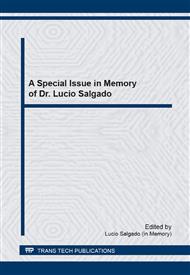[1]
S. Subramanian, K.L. Reifsnider and W.W. Stinchcomb: International Journal of Fatigue Vol. 17 (1995), p.343.
Google Scholar
[2]
A.R. Chambers, J.S. Earl, C.A. Squires and M.A. Suhot: International Journal of Fatigue Vol. 28 (2006), p.1389.
Google Scholar
[3]
M.J. Salkind, Fatigue of Composites. Composite Materials: Testing and Design (Second Conference). s. l.: American Society for Testing and Materials, 1972, 143-169.
DOI: 10.1520/stp27745s
Google Scholar
[4]
P.T. Curtis and B.B. Moore, A Comparison of the Fatigue Performance of Woven and Non-woven CFRP Laminates. London : Royal Aircraft Establishement, 1985. Technical Report 85059.
Google Scholar
[5]
B. Harris: Fatigue in Composites. Boca Raton, Florida USA : CRC Press LLC, (2003).
Google Scholar
[6]
C. Bathias: International Journal of Fatigue Vol. 28 (2006), p.1094.
Google Scholar
[7]
J.E. Lindhagen and L.A. Berglund: Journal of Materials Science Vol. 32 (1997), p.4071.
Google Scholar
[8]
L. Toubal, M. Karama and B. Lorrain: International Journal of Fatigue Vol. 28 (2006), p.1867.
Google Scholar
[9]
H.T. Hahn, J. Bartley-Cho and S.G. Lim, The Effect of Loading Parameters on Fatigue of Composite Laminates: Part II. U.S. Department of Transportation, Federal Aviation Administration. 1997. DOT/FAA/AR-96/76.
Google Scholar
[10]
G. Pinter, E. Ladstatter, W. Billinger and R.W. Langer: International Journal of Fatigue Vol. 28 (2006), p.1277.
Google Scholar
[11]
V. Barron, M. Buggy and N. H. Mckenna: Journal of Materials Science Vol. 36 (2001), p.1755.
Google Scholar
[12]
G. Minak: Journal of Composite Materials Vol. 44 (2010), p.1739.
Google Scholar
[13]
R. Steinberger, T.I. Valadas Leitão, E. Ladstatter, G. Pinter,W. Billinger and R.W. Lang: International Journal of Fatigue Vol. 28 (2006), p.1340.
Google Scholar
[14]
Hexcel Composites. Material Data Sheet - F584. Duxford, UK: s. n., (1998).
Google Scholar
[15]
Department Of Defense - U.S.A. Composite Materials Handbook. 1997. Vol. 1. MIL-HDBK-17-1F.
Google Scholar
[16]
H. T. Hahn, J. L. Timmer, J. Bartley-Cho, S. Lee, S. Lim, The Effect of Preloading on Fatigue Damage in Composite Structures: Part I. U.S. Department of Transportation, Federal Aviation Administration. Washington, D.C. : s. n., 1996. pp.1-36.
Google Scholar
[17]
H. Mao and S. Mahadevan: Composite Structures Vol. 58 (2002), p.405.
Google Scholar
[18]
F. Gao, L. Boniface, S.L. Ogin, P.A. Smith and R.P. Greaves: Composites Science and Technology Vol. 59 (1999), p.123.
Google Scholar
[19]
T.F. Tan and C.K.H. Dharan: Journal of Composite Materials. 2010 INTERNET.
Google Scholar
[20]
F. Wu and W. Yao: International Journal of Fatigue Vol. 32 (2010), p.134.
Google Scholar
[21]
C. Li, F. E. Ellyin and A. Wharmby: Composites: Part B Vol. 34 (2003), p.473.
Google Scholar


